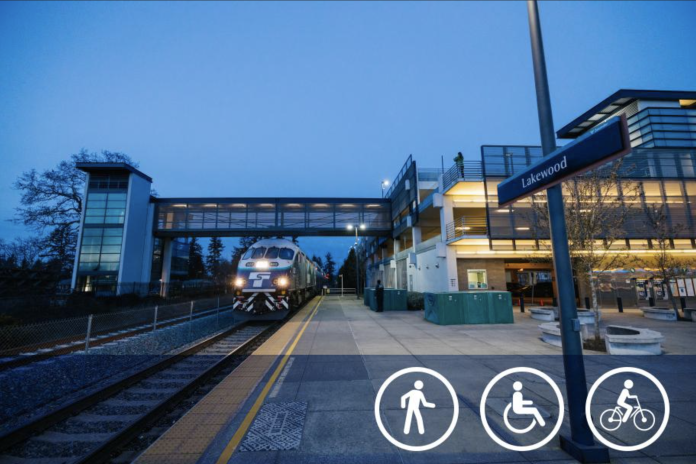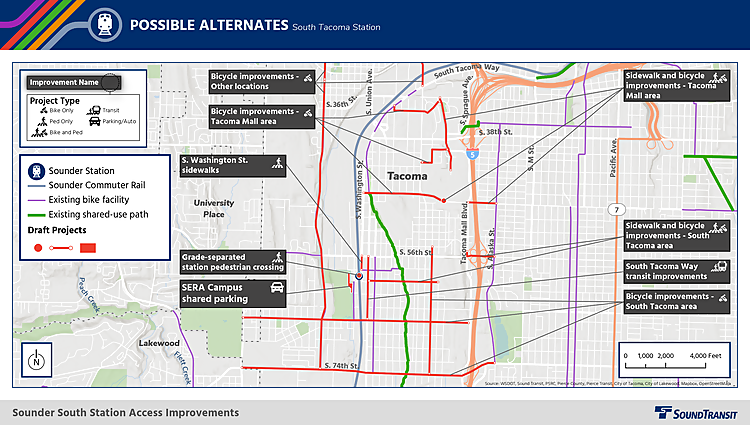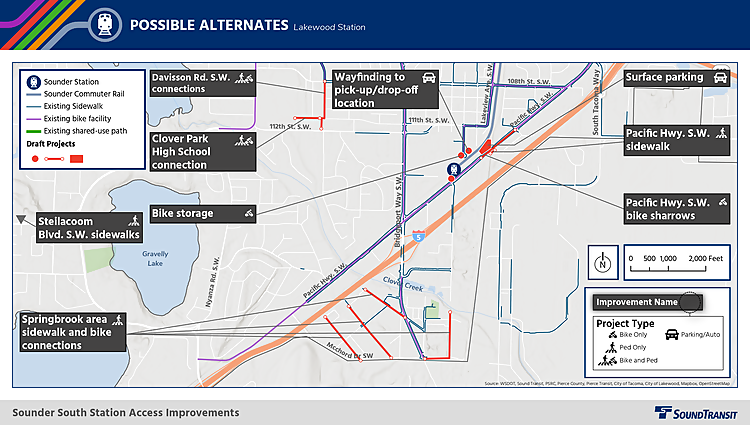Sound Transit has opened an online open house and survey on proposed station access improvements for Sounder commuter rail stations in South Tacoma and Lakewood. These are the last two stations on the S Line until Tillicum and DuPont Stations open in 2045 and are served by seven Sounder trips in each direction on weekdays. The access improvement projects are to be funded as part of the Sound Transit 3 program and implemented by 2030.
Potential projects have gone through a screening and rating process. Sound Transit worked with peer agencies to identify the potential projects and used a series of evaluation criteria based on access, environmental, passenger experience, partnership opportunities, and cost to rate projects. Through the evaluation criteria, projects were then separated into three categories: higher-performing (potential improvements), middle-performing (possible alternatives), and lower-performing (not proposed for further consideration). Higher-performing projects are the most likely candidates for funding and construction, but the open survey could affect decision-making about projects to be selected for further consideration.
Projects that seem to rate best according to the criteria were walk, biking, and some transit enhancements near the stations.
South Tacoma candidate improvements
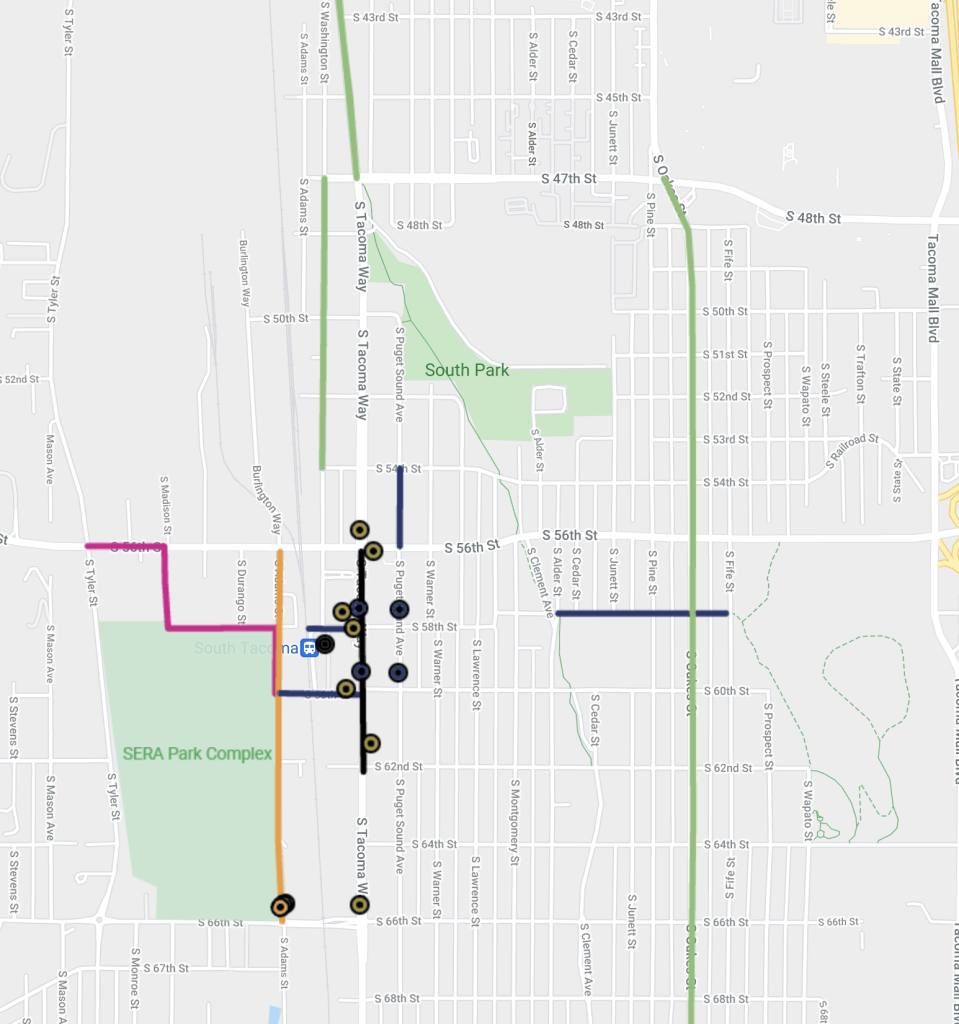
Sound Transit is recommending several buckets of improvements around the South Tacoma Station. As outlined on the map, these include a new bicycle pathway on S 56th Street (pink), bicycle lanes and connections on other local streets (green), a mix of other bike, pedestrian, and accessibility improvements near the station (blue and orange), and bus and bus stop improvements (mustard) — like transit signal priority, transit shelters and lighting, and bus stop relocation. In the immediate station area, Sound Transit is also recommending a bunch of new features, including:
- Improved wayfinding materials;
- A new public address system;
- Tactile pavement for accessibility;
- A new transit shelter for people with disabilities;
- Safer pedestrian crossings of railway tracks; and
- Micromobility parking for scooters and bikes.
Possible alternatives are numerous, but mostly are focused on pedestrian and bike improvements. The big ideas there are a new grade-separated pedestrian crossing at the station that would connect people from the station to the park-and-ride west of it as well as bike improvements on S 74th Street, S 66th Street, and S Tyler Street. A pedestrian bridge would bridge the station on equal footing to Lakewood Station which already has one and could create safer crossings when trains are present. However, the corridor is only likely to have 14 daily passenger rail trips in each direction, including Amtrak Cascades (planned for six daily roundtrips) and Coast Starlight (planned for one daily roundtrip) that won’t stop at the station. Coupled with low station ridership, the value of a new pedestrian bridge is not great and several stations along the S Line have none.
Projects that were eliminated from further consideration include two new I-5 crossings people walking, rolling, and biking, a new parking structure, pedestrian and bike connections on the SERA campus, and Pierce Transit bus reroutes for Routes 3 and 53.
Lakewood Station candidate improvements
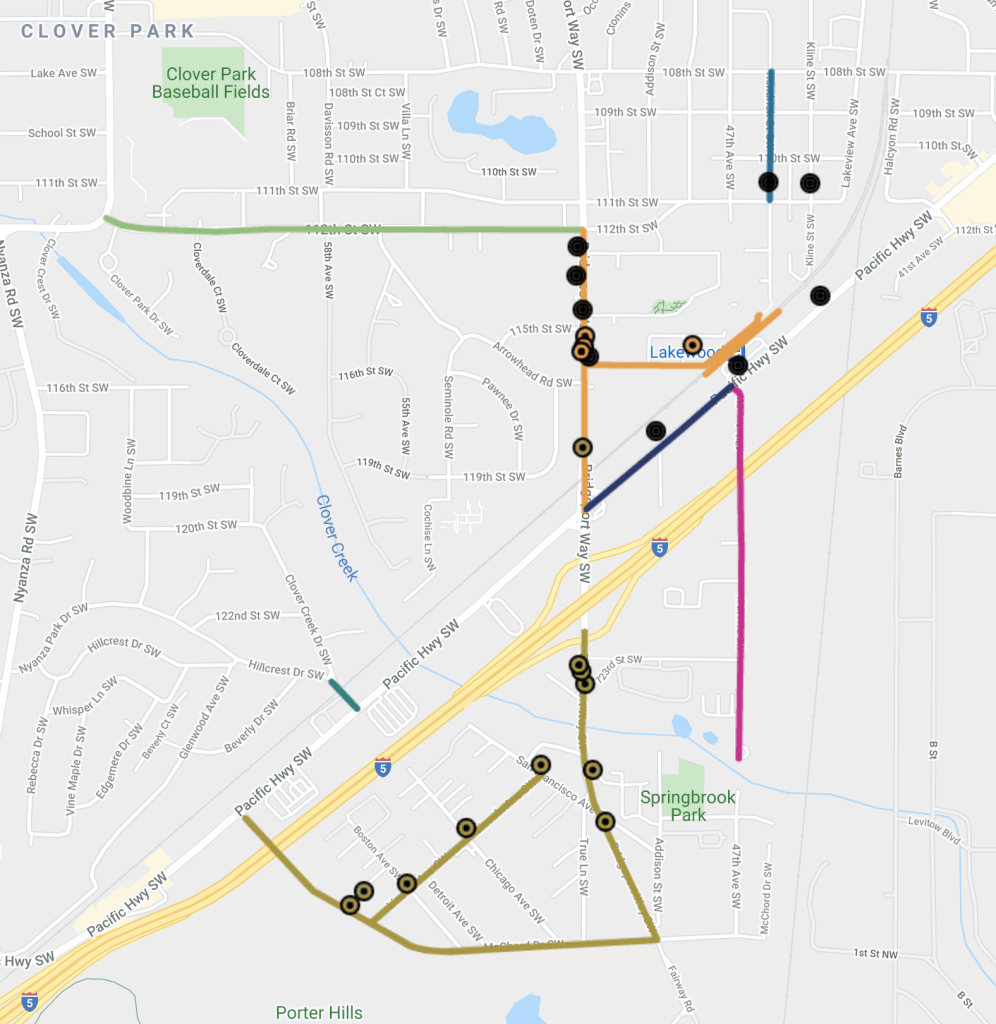
Sound Transit is recommending a modest set of access improvements around Lakewood Station. As outlined on the map, these include new bike lanes as well new and wider sidewalks on 47th Avenue SW (pink), a smorgasbord of enhancements (e.g., lighting, sidewalks, sharrows, and pedestrian crossings) to Bridgeport Way SW and 115th Street Court SW (orange), revising maneavuvering space for buses on Pacific Highway SW (navy), new sidewalks and curb ramps in the Springbrook Park area (gold), and new sidewalks and planter strip on 112th Street SW, Kendrick Street SW, and Clover Creek Drive (green, turquoise, and sea green). In the immediate station area, Sound Transit is also recommending a bunch of new features like South Tacoma Station, including:
- Improved wayfinding materials;
- A new public address system;
- Tactile pavement for accessibility;
- A new transit shelter for people with disabilities;
- Safer pedestrian crossings of railway tracks; and
- Micromobility parking for scooters and bikes.
Compared to the South Tacoma Station area, the possible alternatives is somewhat narrow, but still mostly focused on pedestrian and bike improvements. Streets in the Springbrook area would be the biggest beneficiary new sidewalks and bike sharrows. Clover Park High School and Davisson Road SW could also get new bike lanes, sidewalks, and curb ramps.
Projects that were eliminated from further consideration include pedestrian and bike bridge on 47th Avenue SW across I-5, pedestrian improvements on Gravelly Lake Drive, and new surface or structured parking.
Next steps
There is an opportunity to directly engage with agency staff through a virtual question and answer session on Wednesday, October 20th from 12:00pm to 1:00pm. The session will focus on Lakewood Station. Another virtual drop-in session happened on Monday, October 18th. The online open house and survey will be open through Tuesday, October 26th. Feedback will help identify projects to move forward through the environmental review and conceptual engineering process, which the Sound Transit board of directors will decided upon next year. A final set of projects to proceed to construction will later be determined by the agency board of directors.
Stephen is a professional urban planner in Puget Sound with a passion for sustainable, livable, and diverse cities. He is especially interested in how policies, regulations, and programs can promote positive outcomes for communities. With stints in great cities like Bellingham and Cork, Stephen currently lives in Seattle. He primarily covers land use and transportation issues and has been with The Urbanist since 2014.


